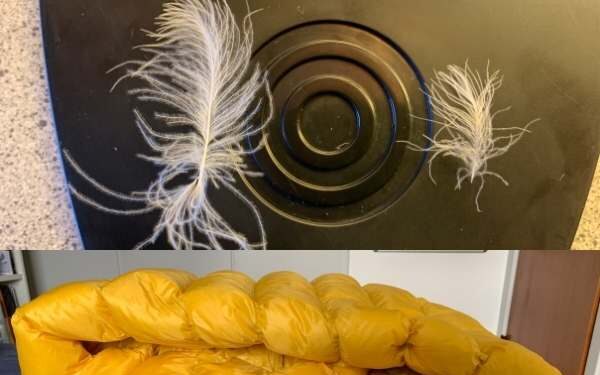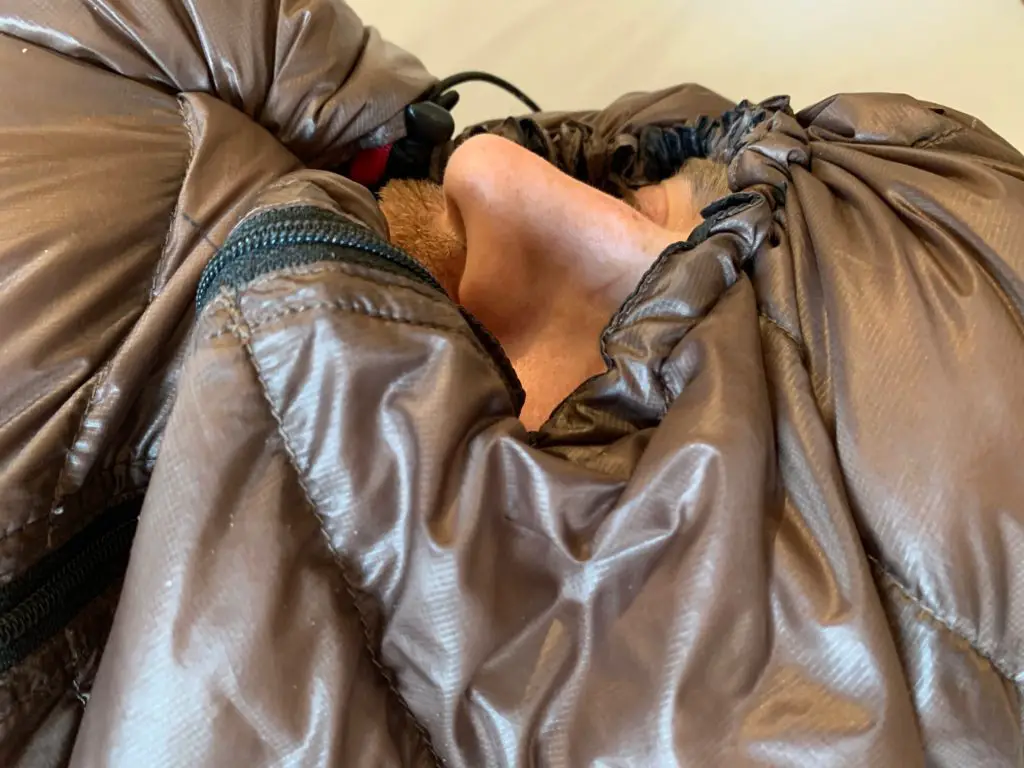Understanding why your down sleeping bag smells like a wet dog involves exploring the unique properties of down, the impact of moisture, and various factors that contribute to odor development.
In this comprehensive guide, we’ll delve into the composition of down sleeping bags, the science behind the ‘wet dog’ odor, common causes of such odors, and practical tips for preventing and eliminating them.
As someone with extensive experience in outdoor adventures and gear maintenance, I’ll share insights and effective strategies to ensure the longevity and freshness of your down sleeping bag.
Understanding the Composition of Down Sleeping Bags
What Makes Down an Ideal Insulation Material
Down, the soft layer of feathers closest to a bird’s skin, primarily from ducks and geese, is renowned for its exceptional insulating properties.

It’s characterized by its lightweight, compressibility, and ability to trap warm air efficiently, making it a favored material for sleeping bags among outdoor enthusiasts.
The unique structure of down clusters forms an intricate network of air pockets, which helps retain body heat and provides superior warmth-to-weight ratio compared to synthetic insulators.
The Role of Feathers and Down in Sleeping Bags
In a down sleeping bag, the blend of feathers and down significantly influences its performance. While down clusters offer excellent loft and insulation, feathers add structure and support. This combination ensures the bag maintains its shape and insulation properties over time, even under varying environmental conditions.
The Science Behind the ‘Wet Dog’ Odor
The notorious ‘wet dog’ smell emanating from down sleeping bags is primarily due to the presence of natural oils and fats found in down and feathers.

When these materials get wet, microbial activity increases, leading to the breakdown of these oils and the release of volatile compounds responsible for the unpleasant odor. Additionally, the scent can be exacerbated by external factors such as sweat, body oils, and environmental moisture.
Microorganisms and Their Impact on Odor
Microbial growth, particularly from bacteria and fungi, plays a significant role in odor development in down sleeping bags. These microorganisms thrive in moist environments and feed on organic matter, including skin cells and natural oils. Their metabolic processes release compounds that contribute to the distinct ‘wet dog’ smell.

Moisture and Its Role in Amplifying Smells
Moisture is a key factor in amplifying odors in down sleeping bags. Humidity, condensation, and external wet conditions can all lead to increased moisture content within the bag, creating an ideal environment for microbial growth and odor production.
The Chemistry of Odors: From Wet Dogs to Sleeping Bags
The chemistry behind the ‘wet dog’ smell is complex. It involves a mix of aldehydes, ketones, and sulfur-containing compounds produced by the breakdown of organic substances under moist conditions.

These compounds are volatile, meaning they easily evaporate at room temperature and become airborne, making them readily detectable by the human nose.
Common Causes of Odors in Down Sleeping Bags
Moisture Accumulation: From Humidity to Precipitation
Moisture can accumulate in down sleeping bags from various sources, including ambient humidity, precipitation, and even body moisture from sweat. This moisture not only provides a breeding ground for microbes but also reduces the insulating effectiveness of down.

Dirt, Sweat, and Body Oils: Unseen Contributors
Regular use of a sleeping bag inevitably leads to the accumulation of dirt, sweat, and body oils. These substances can penetrate the down fill, providing additional food sources for bacteria and fungi, thereby increasing the potential for odor development.
Mold and Mildew: Silent Odor Culprits
Mold and mildew are common issues in down sleeping bags, especially when stored in damp conditions. These fungi release a musty odor and can cause significant damage to the down fill and the fabric of the sleeping bag, leading to reduced insulation and a shorter lifespan.
Practical Tips for Preventing and Eliminating Odors
Proper Storage and Care for Down Sleeping Bags
To maintain the freshness of your down sleeping bag and prevent odor buildup, proper storage is crucial. Always store the bag in a cool, dry place, ideally in a large, breathable storage sack rather than a compressed state. This allows the down to maintain its loft and prevents moisture accumulation, which can lead to mold and mildew growth.

Cleaning Techniques: From Air Drying to Washing
Regular cleaning is essential for managing odors in down sleeping bags. Light airing out after each use can help dissipate body odors and moisture.
For deeper cleaning, washing the bag either by hand or in a front-loading washing machine with a gentle, down-specific detergent is recommended. Avoid using fabric softeners or harsh chemicals, as these can damage the down and reduce its insulating properties.
Washing a sleeping bag follows the same principles as for washing a puffer down jacket that I’ve written about here on the site.
Air drying is the best method for drying down sleeping bags. It’s important to dry the bag completely before storage to prevent mildew growth. You can also use a low-heat setting in a large commercial dryer, along
with tennis balls or dryer balls, to help break up down clumps and restore loft.
Odor Removal Strategies: Natural and Chemical Solutions
For targeted odor removal, there are several effective strategies:
- Baking Soda: Sprinkle baking soda inside the bag and let it sit for a few hours before shaking it out and airing the bag. Baking soda is a natural deodorizer that can neutralize odors without harming the down.
- Vinegar Solution: A mild solution of vinegar and water can help neutralize odors. Soak the bag in the solution, then rinse thoroughly and dry.
- Commercial Odor Removers: There are specialized products designed for down gear that can effectively eliminate odors without damaging the material.
Understanding Manufacturing Variables
Variations in Down Quality and Processing
The quality of down and the processing methods used in manufacturing sleeping bags can significantly impact odor tendencies. Higher-quality down typically undergoes more thorough cleaning and processing, which can reduce the presence of natural oils and fats that contribute to odors.
How Manufacturing Processes Affect Odor Development
The way down is treated during the manufacturing process, including cleaning, sorting, and sterilization, plays a crucial role in odor development. Better processed down will have fewer residual oils and therefore less propensity for developing that ‘wet dog’ smell when exposed to moisture.
Conclusion
In conclusion, understanding the causes behind the ‘wet dog’ smell in down sleeping bags and adopting proper care and cleaning practices are key to maintaining their freshness and longevity. By being mindful of moisture, regularly cleaning your bag, and storing it properly, you can significantly reduce the likelihood of unpleasant odors and ensure your sleeping bag remains a reliable companion on your outdoor adventures.




